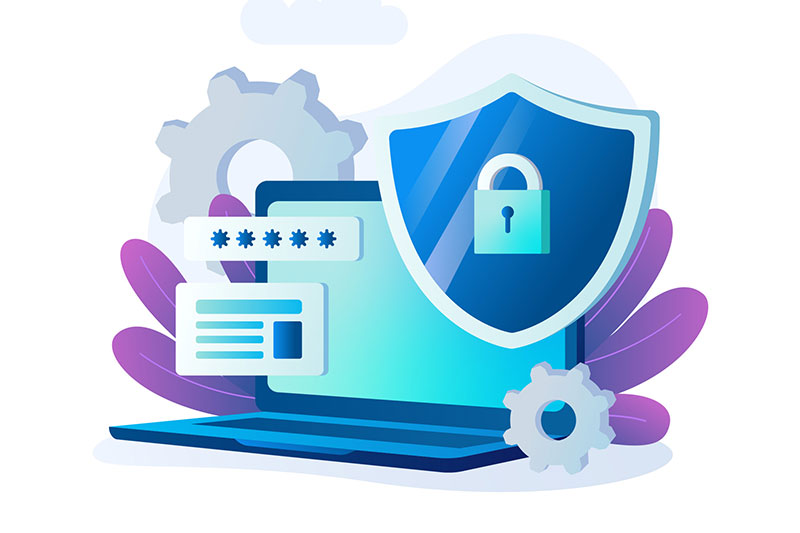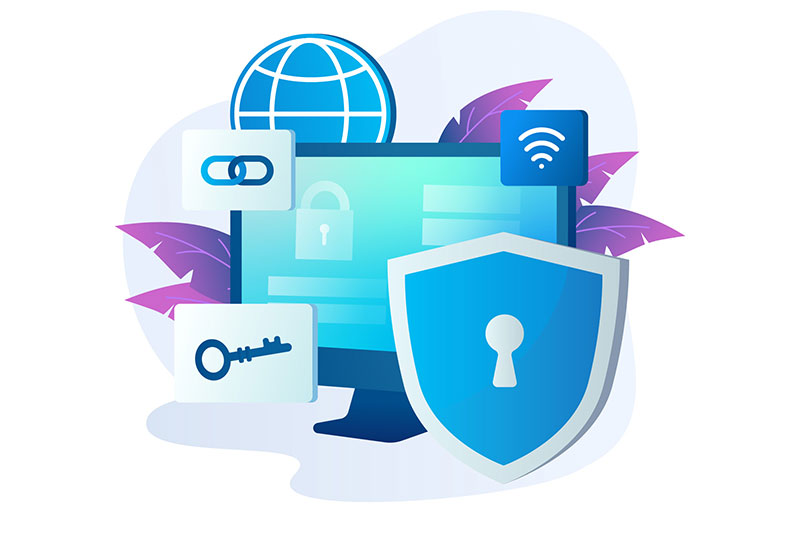Why E-Learning Platforms Are Investing in Advanced Security Features
The e-learning market has been going from strength to strength, with a valuation of over $200 billion and an anticipated annual growth rate in excess of 20%. Unfortunately, this kind of conspicuous success attracts the attention not only of legitimate customers, but malicious actors as well.
This reality is encouraging e-learning platforms providers to ramp up their investment in forward-thinking security measures.
Here’s a look at the types of tech that are being embraced in this niche in response to a raft of new threats.

Earning Trust to Fuel the Growth of E-Learning Platforms
As e-learning platforms become central to education and corporate training, they’re amassing vast amounts of personal and proprietary information.
This brings cybercriminals sniffing around mission-critical systems, threatening not only the integrity of operations but also the reputation of the platforms being targeted.
Estimates of the costs of a data breach vary, with IBM pegging the average at $4.45 million, while Statista cites a more worrying $9.48 million typical outlay.
The problem is exacerbated by the fact that affected e-learning platforms inevitably lose the trust of users, and it can take years to earn this back.
Investing in advanced security features has become essential for the following reasons:
- Digital Identity Protection: Sophisticated encryption methods ensure that user identities are kept confidential, reducing the risk of identity theft.
- Intellectual Property Safeguards: Content protection mechanisms prevent unauthorized distribution or theft of course materials.
- Compliance with Standards: Adherence to international regulations like GDPR puts up guardrails in the face of cyber sprawl, and also prevents punitive fines from being issued following a breach.
For e-learning platforms, understanding how to implement GDPR compliance is necessary to protecting user data and maintaining trust. By investing in advanced security features, these platforms can ensure that they meet GDPR requirements, safeguarding sensitive information and making their online learning spaces safer for everyone.
Key among these advanced features is containerization in cybersecurity, which describes a method where applications are isolated within “containers”, making breaches much less likely to compromise the entire system.
This approach recognizes that a breach is inevitable at some point, and so restricting it to just a small part of a larger ecosystem is better than giving hackers free reign to wreak havoc if they can find one point of vulnerability to exploit.
The knock-on effect of splashing out on cutting-edge security is that user trust is earned and sustained, which in turn allows for the rapid growth of e-learning brands. So it’s about commercial viability and marketing clout as much as it is about data protection.
– Benefits of Corporate Training for Companies
Advantages of Defending Data on E-Learning Platforms
It’s worth emphasizing just how frequently educational institutions and organizations are in the firing line of cyber crooks – with data from the UK revealing that higher education is especially vulnerable, resulting in 97% of surveyed operators in this space admitting that some form of attack had occurred in the past 12 months.
E-learning platforms, which are innately reliant on providing digital access to learning resources to users, therefore have an even greater imperative motivating them to limit exposure to risks in this context.
If this wasn’t reason enough to get serious about security, here are a few more factors that are in contention:
- Ethical Data Management: Upholding ethical standards requires rigorous controls over how user data is handled and shared. So it’s not just a case of worrying about what outsider threats might mean for system integrity, but also the role that internal policies have to play in preventing misuse, loss and breaches, whether accidental or not.
- Enhanced User Control: Giving users greater control over their data fosters transparency and trust, as well as being part of a positive customer experience in any online course. This means you can’t just claim to have beefed up security at your end to attract users, but also prove that you’re committed to this when they start interacting with your services.
- Strategic Data Analytics: Securely analyzing user data can provide insights for personalized learning experiences, while respecting privacy. So it’s not a case of eliminating the storage of sensitive data for fear that it will leak, but rather protecting it to extract value and push the platform forward.
This conscientious approach to cybersecurity ensures compliance with legal frameworks and also elevates the platform’s standing in the eyes of stakeholders who value their privacy and rights.
– 9 Ways to Improve Customer Experience in eLearning
Enhancing Interactivity While Ensuring Security on E-Learning Platforms
The convergence of interactivity in e-learning platforms and the necessity for robust security measures presents a dynamic challenge for developers and providers.
Interactive features are instrumental in engaging learners and delivering a richer educational experience, but they also introduce new vulnerabilities that malicious actors can exploit.
To balance these competing priorities, industry innovators are leaning into solutions that preserve the integrity of user data without diminishing the interactive quality of their offerings. This requires:
- Real-time Monitoring and Mitigation: Advanced systems now include real-time threat detection which can identify and neutralize threats before they cause harm, ensuring a safe learning environment without interrupting the user’s experience.
- Data Encryption at Rest and In-transit: Utilizing high-level encryption both for stored data (at rest) and during data transfer (in-transit) means personal information is obscured from unauthorized viewers at all stages.
- Secure APIs for Third-party Integrations: As e-learning platforms often integrate with various third-party tools to enhance interactivity, secure API gateways are implemented to ensure these connections don’t become back doors for cyber threats.
The per-employee spend for cybersecurity currently sits at just over $52, which gives a sense of how costs can scale depending on the scope of the e-learning platforms in question – and also explains why the total market will be worth over $183 billion by the end of the year, with the majority of expenditure focused in the US.
This is not money down the drain – and instead represents an investment in ensuring that interactivity doesn’t also bring greater risks along with it.
– Innovative Strategies for Engaging Students
Mobile E-Learning from a Security Perspective
The shift towards mobile learning (mLearning) has amplified the necessity to safeguard sensitive data across various devices and networks – and given that smartphone ownership levels now sit at 54% of the world’s population, or 4.3 billion individuals, this is a vast market that needs to be plumbed as well as protected.
The integration of stringent security protocols specifically designed for mobile applications underscores this commitment to protecting users irrespective of how they access content, and covers aspects including:
- Device Management and Authentication: Implementing multi-factor authentication (MFA) and secure device management ensures that only authorized users can access the e-learning content on their mobile devices – rather than anyone with a network connection and a compulsion for cyber mischief.
- Secure Mobile App Development: By adopting a ‘security by design’ approach in app development, providers can minimize vulnerabilities from the outset, ensuring that applications are resilient against intrusions, whatever form they take.
- Regular Security Audits and Updates: Continuous assessment of mobile apps for potential security risks followed by immediate deployment of patches is the best medicine in the face of cybercrime.
A 2022 study conducted by Verizon found that 82% of breaches came down to people rather than systems being vulnerable to exploitation – thus highlighting the importance not just of technological solutions but also user education in maintaining cybersecurity.
Therefore, part of securing mLearning involves educating users about safe practices like recognizing phishing attempts and using secure network connections when accessing their courses.
This is essentially another illustration of how important it is for e-learning platforms not only to evolve in order to engage with and impress more users, but also to take into account the near certainty that at some point, they’ll be in the firing line with a malicious actor lining up their sights.
– How to create mobile learning courses
Leveraging AI for Proactive Cybersecurity in E-Learning Platforms
Artificial intelligence (AI) is helping e-learning platforms predict, detect, and respond to cybersecurity threats far quicker and more efficiently than was possible in the past.
Integrating AI means platforms can anticipate potential vulnerabilities and neutralize threats proactively – which is far more desirable than only being equipped with reactive security measures. Here’s a closer look at what the latest tools enable in this context:
- Anomaly Detection: AI algorithms are trained to recognize patterns of normal user behavior and can swiftly flag any activity that strays from these patterns, indicating a potential security breach in a matter of milliseconds, rather than leaving it to rumble along unnoticed for months. We know that it can literally take hundreds of days for breach detection to occur in many cases, so AI’s impact really cannot be overstated here.
- Predictive Analytics: Leveraging historical data means AI can predict likely attack vectors and inform administrators about system weaknesses before they are exploited, yet again overcoming the kinds of hurdles that humans used to find insurmountable with ease.
- Automated Incident Response: With AI-driven tools in place, e-learning platforms can automate certain responses to security incidents, reducing the time between detection and resolution, while taking the pressure of the people at the steering wheel, and allowing them to be more involved in top-level strategies and decision-making.
Of course it’s worth mentioning that while AI is a huge help from a security perspective, it’s also a potential threat in its own right – with a McKinsey survey finding that 53% of businesses are worried about what generative machine learning models might mean for their ability to protect their digital assets.
That said, there’s a lot that e-learning platforms stand to gain from bringing AI onboard, not only for security but also as a means of enhancing learning experiences – so this is one development that seems predominantly positive.
– Best AI tools for creating online courses
Choose the Right Platform and Ensure the Security of Your Business

It’s a given that good e-learning platforms will have a major focus on providing comprehensive security to both prevent private user data from being stolen and defend against all sorts of other disruptive mischief that might occur in the event of a breach.
However, it’s just as necessary for platform providers to not simply rest on their laurels once they’ve implemented more stringent measures, because threats don’t just tread water, but actively surge forward to seek new vulnerabilities to exploit.
The benefits of being well-protected far outweigh the issues that come with making necessary changes, such as upfront costs and the need for additional employee training.
Customers will come flocking, the user experience will blossom, and analysis of data generated by platforms can bring with it new insights to generate growth.
In compliance with all data protection laws and requirements, Coursify.me is a secure, dynamic and customizable Learning Management System.
– Whats is a Learning Management System
Serving companies and professionals in more than 60 countries, it is the ideal solution for those who want to create, promote and sell courses on the internet.
It is important to note that Coursify.me hosts every online course with redundancy and backup so you have a safe and reliable environment.
To know more, visit our website, test the platform and understand why we are the best option for your business.

